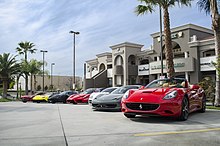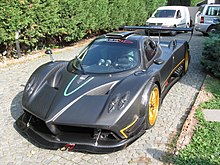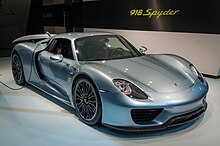SUPERCARS:-
History
An advertisement for the Ensign Six, a 6.7 L (410 cu in) high-performance car similar to the Bentley Speed Six, appeared in The Times for 11 November 1920 with the phrase "If you are interested in a supercar, you cannot afford to ignore the claims of the Ensign 6." The Oxford English Dictionary also cites the use of the word in an advertisement for an unnamed car in The Motor dated 3 November 1920, "The Supreme development of the British super-car."and defines the phrase as suggesting "a car superior to all others". A book published by the Research Institute of America in 1944, that previewed the economic and industrial changes to occur after World War II, used the term "supercar" (author's emphasis) to describe future automobiles incorporating advances in design and technology such as flat floorpans and automatic transmissions.In the United States, the term "supercar" predates the classification of muscle car to describe the "dragstrip bred" affordable mid-size cars of the 1960s and early 1970s that were equipped with large, powerful V8 engines and rear wheel drive.The combination of a potent engine in a lightweight car began with the 1957 Rambler Rebel that was described as a "veritable supercar"."In 1966 the sixties supercar became an official industry trend" as the four domestic automakers "needed to cash in on the supercar market" with eye-catching, heart-stopping cars.Among the numerous examples of the use of the supercar description include the May 1965 issue of the American magazine Car Life, in a road test of the Pontiac GTO, as well as how "Hurst puts American Motors into the Supercar club with the 390 Rogue" (the SC/Rambler) to fight in "the Supercar street racer gang" market segment. The "SC" in the model name stood for "SuperCar".The supercar market segment included regular production models in different muscle market segments (such as the "economy supercar"), as well as limited edition, documented dealer-converted vehicles.
The word supercar later came to mean a "GT" or grand touring type of car. By the 1970s and 1980s the phrase was in regular use, if not precisely defined.
During the late 20th century, the term supercar was used to describe "a very expensive, fast or powerful car with a centrally located engine", and stated in more general terms: "it must be very fast, with sporting handling to match", "it should be sleek and eye-catching" and its price should be "one in a rarefied atmosphere of its own"
The supercar term has also been applied to technologically advanced vehicles using new fuel sources, powerplants, aerodynamics, and lightweight materials to develop an 80 mpg-US (2.9 L/100 km; 96 mpg-imp) family-sized sedan. "Supercar" was the unofficial description for the United States Department of Commerce R&D program, Partnership for a New Generation of Vehicles (PNGV).The program was established to support the domestic U.S. automakers (GM, Ford, and Chrysler) develop prototypes of a safe, clean, affordable car the size of the Ford Taurus, but delivering three times the fuel efficiency
A supercar is a high-performance sports car or grand tourer. The term is used in marketing by
automakers for unusual, high-end vehicles, and has been used to refer to at least four different sorts of cars:
 |
| Several supercars at a meet |
- Limited-production specials from an "elite" automaker
- Standard-looking cars modified for power and performance
- Models that appeal to enthusiasts, from smaller manufacturers
- One-of-a-kind "showcase" project vehicles built by custom car retrofitters (usually extensively modified collectible muscle cars or grand tourers updated to the latest "streetable" racing technology).


 Several supercars at a meet
Several supercars at a meetHistory
An advertisement for the Ensign Six, a 6.7 L (410 cu in) high-performance car similar to the Bentley Speed Six, appeared in The Times for 11 November 1920 with the phrase "If you are interested in a supercar, you cannot afford to ignore the claims of the Ensign 6."The Oxford English Dictionary also cites the use of the word in an advertisement for an unnamed car in The Motor dated 3 November 1920, "The Supreme development of the British super-car." and defines the phrase as suggesting "a car superior to all others". A book published by the Research Institute of America in 1944, that previewed the economic and industrial changes to occur after World War II used the term "supercar" (author's emphasis) to describe future automobiles incorporating advances in design and technology such as flat floorpans and automatic transmissions.
In the United States, the term "supercar" predates the classification of muscle car to describe the "dragstrip bred" affordable mid-size cars of the 1960s and early 1970s that were equipped with large, powerful V8 engines and rear wheel drive.The combination of a potent engine in a lightweight car began with the 1957 Rambler Rebel that was described as a "veritable supercar". "In 1966 the sixties supercar became an official industry trend" as the four domestic automakers "needed to cash in on the supercar market" with eye-catching, heart-stopping cars. Among the numerous examples of the use of the supercar description include the May 1965 issue of the American magazine Car Life, in a road test of the Pontiac GTO, as well as how "Hurst puts American Motors into the Supercar club with the 390 Rogue"(the SC/Rambler) to fight in "the Supercar street racer gang" market segment.The "SC" in the model name stood for "SuperCar". The supercar market segment included regular production models in different muscle market segments (such as the "economy supercar", as well as limited edition, documented dealer-converted vehicles.
The word supercar later came to mean a "GT" or grand touring type of car.By the 1970s and 1980s the phrase was in regular use, if not precisely defined.
During the late 20th century, the term supercar was used to describe "a very expensive, fast or powerful car with a centrally located engine", and stated in more general terms: "it must be very fast, with sporting handling to match", "it should be sleek and eye-catching" and its price should be "one in a rarefied atmosphere of its own".
The supercar term has also been applied to technologically advanced vehicles using new fuel sources, powerplants, aerodynamics, and lightweight materials to develop an 80 mpg-US (2.9 L/100 km; 96 mpg-imp) family-sized sedan. "Supercar" was the unofficial description for the United States Department of Commerce R&D program, Partnership for a New Generation of Vehicles (PNGV). The program was established to support the domestic U.S. automakers (GM, Ford, and Chrysler) develop prototypes of a safe, clean, affordable car the size of the Ford Taurus, but delivering three times the fuel efficiency


